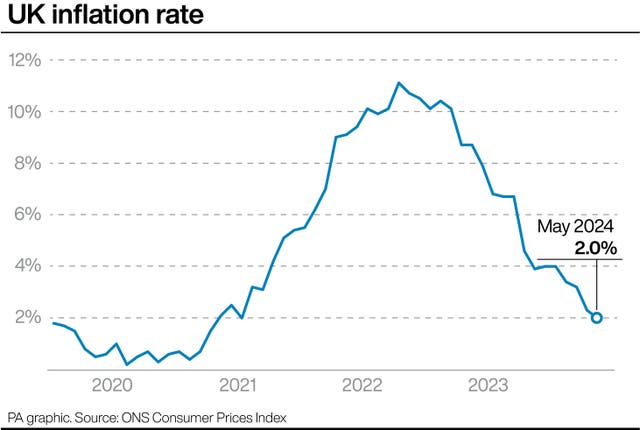Inflation returns to 2% target for first time in nearly three years
The Office for National Statistics said Consumer Prices Index inflation fell to 2% in May, down from 2.3% in April.

Inflation has returned to the 2% target for the first time in almost three years in what comes at a critical time, just weeks before the nation heads to the polls.
The Office for National Statistics (ONS) said Consumer Prices Index (CPI) inflation fell to 2% in May, down from 2.3% in April.
It follows nearly three years of above-target inflation, with CPI last recorded at 2% in July 2021, before shooting higher amid the cost-of-living crisis.

The latest inflation figures mean that prices are still rising across the country, but at a much slower rate than in recent years when households and businesses were being squeezed during the peak of the cost crisis.
The data will be watched closely ahead of the Bank of England’s next interest rate decision on Thursday, but policymakers are widely expected to hold fire on any cuts until after the General Election on July 4.
It comes less than three weeks before polling day and as the political parties home in on economic pledges in their manifestos.
The fall in inflation is likely to be seized on by Rishi Sunak’s Conservatives as a sign that their economic plan is working.
But shadow chancellor Rachel Reeves said: “After 14 years of economic chaos under the Conservatives, working people are worse off.
“Prices have risen in the shops, mortgage bills are higher and taxes are at a 70-year high.”
Liberal Democrat Treasury spokeswoman Sarah Olney said: “The hard truth is that millions of people won’t be feeling any better off today.”
Experts said that, despite the milestone for inflation, there is still work to do in bringing down prices throughout the economy.
The Bank is keeping a watchful eye on inflation in the services sector, which fell from 5.9% to 5.7% in May, but still remains stubbornly high.
It is one of the factors that has been partly responsible for staying the Bank’s hand in bringing rates down from their 16-year high of 5.25%.
Jake Finney, economist at PwC, warned it is “not ‘job done’ yet”.
He said: “If prices continue to rise at the same month-on-month rate as they did this month (0.3%), then headline inflation will be back over the 2% target next month (at 2.1%).”
Suren Thiru, economics director at Institute of Chartered Accountants in England and Wales (ICAEW), said: “Despite this landmark fall in inflation, concerns over both underlying price pressures and changing policy in the run-up to a General Election means a June interest rate cut is almost certainly off the table.”
The ONS said food inflation fell back to 1.6% – the lowest since October 2021 – which was the biggest factor in pulling the overall level of CPI inflation lower.
At one stage food inflation reached nearly 20% – at 19.6% – in March last year, but has been steadily easing back since then.
However, last month saw prices rise at the petrol pumps, while air fares also lifted, according to the ONS.
The average price of petrol rose by 0.7p per litre between April and May to stand at 148.8p per litre.





